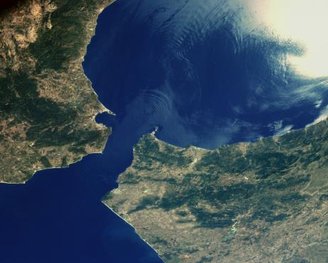Analysis of the shape of seismic waves recorded in the 2010 earthquake deep within the city of Granada in Spain led a team of researchers to a surprising revelation: An oceanic plate that subducts beneath the western Mediterranean and flips over.
The research, detailed in a paper published in the journal The Seismic Record, reflects the image of a tectonic plate being pushed beneath the Earth’s surface and descending abnormally quickly into the Earth’s mantle. Along the way, it changed direction and flipped upside down, causing the large amount of water it carried to end up underneath, in the Earth’s mantle.
In addition to being related to geology, the find expands the understanding of tectonic processes in the analyzed region and provides new clues about the complex tectonic structure of the Western Mediterranean basin. There the African and Eurasian plates move towards each other, creating arc-shaped mountain ranges.It characterizes the region called Rif-Betic-Alboran.
Unusual wave patterns in an ancient earthquake
The first author of the paper, Daoyuan Sun of the University of Science and Technology of China, stated in a press release that the initial goal of the research was simply to “better understand the deep mechanisms of earthquakes.” spring well Our aim was to trace the waveforms just out of curiosity,” admitted the geologist.
But during analysis of seismic wave data, researchers detected some unusual patterns, such as “long codas”. [parte prolongada das ondas sísmicas após um terremoto] and an extra phase.” This additional phase does not occur in the usual patterns of seismic activity.
Submerged sheets often show a low-velocity layer on their surface due to the amount of water they carry; however, in the current study, researchers identified a low-velocity layer beneath the plate that bends in a northeast direction. In this way This study is the first to conclude that the slab was upside down rather than vertical or inclined..
Describes deep earthquakes in Spain

The location of this low velocity layer Provides possible explanation for Spain’s deep earthquakes: presence of hydrated magnesium silicates, Minerals that become brittle when they lose water and cause seismic movements at great depths.
The presence of hydrated silicates also provides reliable clues about the rate of plate subduction in that region.
Considering the relatively young age of the depths of the western Mediterranean for the plate to remain cold, Sun concludes that “the rate of subduction must be quite rapid, such as a moderate rate of about 70 millimeters per year.”
Did you like the content? So stay up to date with more studies like this on TecMundo and seize the opportunity to understand why the tectonic plates in the Pacific Ocean are moving apart.
Source: Tec Mundo
I’m Blaine Morgan, an experienced journalist and writer with over 8 years of experience in the tech industry. My expertise lies in writing about technology news and trends, covering everything from cutting-edge gadgets to emerging software developments. I’ve written for several leading publications including Gadget Onus where I am an author.













